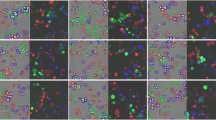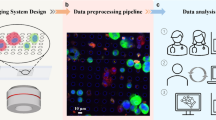Abstract
Circulating tumour cells (CTCs) found in the blood of cancer patients are a promising biomarker in precision medicine. However, their use is currently hindered by their low frequency, tedious manual scoring and extensive cell heterogeneities. Those challenges limit the effectiveness of classical machine-learning methods for automated CTC analysis. Here, we combine autoencoding convolutional neural networks with advanced visualization techniques. This provides a very informative view on the data that opens the way for new biomedical research questions. We unravel hidden information in the raw image data of fluorescent images of blood samples enriched for CTCs. Our network classifies fluorescent images of single cells in five different classes with an accuracy, sensitivity and specificity of over 96%, and the obtained CTC counts predict the overall survival of cancer patients as well as state-of-the-art manual counts. Moreover, our network excelled in identifying different important subclasses of objects. Deep learning was faster and superior to classical image analysis approaches and enabled the identification of new biological phenomena.
This is a preview of subscription content, access via your institution
Access options
Access Nature and 54 other Nature Portfolio journals
Get Nature+, our best-value online-access subscription
$29.99 / 30 days
cancel any time
Subscribe to this journal
Receive 12 digital issues and online access to articles
$119.00 per year
only $9.92 per issue
Buy this article
- Purchase on Springer Link
- Instant access to full article PDF
Prices may be subject to local taxes which are calculated during checkout








Similar content being viewed by others
Data availability
Code availability
The accompanying code for this manuscript is publicly available at https://github.com/LeonieZ/DLofCTCs.
References
Hayes, D. F. et al. Circulating tumor cells at each follow-up time point during therapy of metastatic breast cancer patients predict progression-free and overall survival. Clin. Cancer Res. 12, 4218–4224 (2006).
Cohen, S. J. et al. Relationship of circulating tumor cells to tumor response, progression-free survival, and overall survival in patients with metastatic colorectal cancer. J. Clin. Oncol. 26, 3213–3221 (2008).
de Bono, J. S. et al. Circulating tumor cells predict survival benefit from treatment in metastatic castration-resistant prostate cancer. Clin. Cancer Res. 14, 6302–6309 (2008).
Tol, J. et al. Circulating tumour cells early predict progression-free and overall survival in advanced colorectal cancer patients treated with chemotherapy and targeted agents. Ann. Oncol. 21, 1006–1012 (2010).
Coumans, F. A., Ligthart, S. T. & Terstappen, L. W. Interpretation of changes in circulating tumor cell counts. Transl. Oncol. 5, 486–491 (2012).
Ignatiadis, M. et al. International study on inter-reader variability for circulating tumor cells in breast cancer. Breast Cancer Res. 16, R43 (2014).
Kraan, J. et al. External quality assurance of circulating tumor cell enumeration using the CellSearchⓇ system: a feasibility study. Cytometry B 80, 112–118 (2011).
Zeune, L. et al. Quantifying HER-2 expression on circulating tumor cells by ACCEPT. PLoS One 12, e0186562 (2017).
Zeune, L. L. et al. How to agree on a CTC: evaluating the consensus in circulating tumor cell scoring. Cytometry A 93, 1202–1206 (2018).
Zeune, L. ACCEPT (GitHub Repository, 2017); https://github.com/LeonieZ/ACCEPT
Zeune, L., van Dalum, G., Terstappen, L. W., van Gils, S. A. & Brune, C. Multiscale segmentation via Bregman distances and nonlinear spectral analysis. SIAM J. Imaging Sci. 10, 111–146 (2017).
Nanou, A. et al. Circulating tumor cells, tumor-derived extracellular vesicles and plasma cytokeratins in castration-resistant prostate cancer patients. Oncotarget 9, 19283–19293 (2018).
de Wit, S. et al. Classification of cells in CTC-enriched samples by advanced image analysis. Cancers 10, 377 (2018).
Ko, J. et al. Machine learning to detect signatures of disease in liquid biopsies—a user’s guide. Lab Chip 18, 395–405 (2018).
Raub, C. B. & Nehmetallah, G. Holography, machine learning, and cancer cells. Cytometry A 91, 754–756 (2017).
Lannin, T. B., Thege, F. I. & Kirby, B. J. Comparison and optimization of machine learning methods for automated classification of circulating tumor cells. Cytometry A 89, 922–931 (2016).
Svensson, C.-M., Hübler, R. & Figge, M. T. Automated classification of circulating tumor cells and the impact of interobserver variability on classifier training and performance. J. Immunol. Res. 2015, 1–9 (2015).
Mao, Y., Yin, Z. & Schober, J. M. Iteratively training classifiers for circulating tumor cell detection. In 2015 IEEE 12th International Symposium on Biomedical Imaging (ISBI) 190–194 (IEEE, 2015).
Svensson, C.-M., Krusekopf, S., Lücke, J. & Thilo Figge, M. Automated detection of circulating tumor cells with naive Bayesian classifiers. Cytometry A 85, 501–511 (2014).
Chen, C. L. et al. Deep learning in label-free cell classification. Sci. Rep. 6, 21471 (2016).
Mao, Y., Yin, Z. & Schober, J. A deep convolutional neural network trained on representative samples for circulating tumor cell detection. In 2016 IEEE Winter Conference on Applications of Computer Vision (WACV) 1–6 (IEEE, 2016).
LeCun, Y. A., Bengio, Y. & Hinton, G. E. Deep learning. Nature 521, 436–444 (2015).
Litjens, G. et al. A survey on deep learning in medical image analysis. Med. Image Anal. 42, 60–88 (2017).
Ching, T. et al. Opportunities and obstacles for deep learning in biology and medicine. J. R. Soc. Interface 15, 20170387 (2018).
Eulenberg, P. et al. Reconstructing cell cycle and disease progression using deep learning. Nat. Commun. 8, 463 (2017).
Vidal, R., Bruna, J., Giryes, R. & Soatto, S. Mathematics of deep learning. Preprint at https://arxiv.org/pdf/1712.04741.pdf (2017).
Montavon, G., Samek, W. & Müller, K.-R. Methods for interpreting and understanding deep neural networks. Digital Signal Process. 73, 1–15 (2018).
Van Der Maaten, L. J. P. & Hinton, G. E. Visualizing high-dimensional data using t-SNE. J. Mach. Learn. Res. 9, 2579–2605 (2008).
Zeiler, M. D. & Fergus, R. Visualizing and understanding convolutional networks. In Lecture Notes in Computer Science (including subseries Lecture Notes in Artificial Intelligence and Lecture Notes in Bioinformatics) Vol. 8689, 818–833 (Springer, 2014).
Bengio, Y., Courville, A. & Vincent, P. Representation learning: a review and new perspectives. IEEE Trans. Pattern Anal. Mach. Intell. 35, 1798–1828 (2013).
Le, L., Patterson, A. & White, M. Supervised autoencoders: improving generalization performance with unsupervised regularizers. In Proceedings of the 32nd International Conference on Neural Information Processing Systems 107–117 (NIPS, 2018).
Zhang, Y., Lee, K. & Lee, H. Augmenting supervised neural networks with unsupervised objectives for large-scale image classification. In Proceedings of the 33rd International Conference on Machine Learning 48, 612–621 (JMLR, 2016).
Cristofanilli, M. et al. Circulating tumor cells, disease progression, and survival in metastatic breast cancer. New Eng. J. Med. 351, 781–791 (2004).
Hinton, G. et al. Deep neural networks for acoustic modeling in speech recognition. IEEE Signal Process. Mag. 29, 82–97 (2012).
Krizhevsky, A., Sutskever, I. & Hinton, G. E. ImageNet classification with deep convolutional neural networks. Adv. Neural Inform. Process. Syst. 25, 1097–1105 (2012).
Ronneberger, O., Fischer, P. & Brox, T. U-Net: convolutional networks for biomedical image segmentation. In International Conference on Medical Image Computing and Computer-Assisted Intervention Vol. 9351, 234–241 (LNCS, 2015).
Vincent, P., Larochelle, H., Bengio, Y. & Manzagol, P.-A. Extracting and composing robust features with denoising autoencoders. In Proceedings of the 25th International Conference on Machine Learning 1096–1103 (ACM, 2008).
Kapil, A. et al. Deep semi supervised generative learning for automated PD-L1 tumor cell scoring on NSCLC tissue needle biopsies. Sci. Rep. 8, 17343 (2018).
Long, J., Shelhamer, E. & Darrell, T. Fully convolutional networks for semantic segmentation. In Proceedings of the IEEE Conference on Computer Vision and Pattern Recognition 3431–3440 (IEEE, 2015).
Erhan, D., Courville, A. & Vincent, P. Why does unsupervised pre-training help deep learning?. J. Mach. Learn. Res. 11, 625–660 (2010).
Ghifary, M., Kleijn, W. B., Zhang, M., Balduzzi, D. & Li, W. Deep reconstruction-classification networks for unsupervised domain adaptation. In Lecture Notes in Computer Science (including subseries Lecture Notes in Artificial Intelligence and Lecture Notes in Bioinformatics) Vol. 9908, 597–613 (Springer, 2016).
Liu, J., Xu, B., Shen, L., Garibaldi, J & Qiu, G. HEp-2 cell classification based on a deep autoencoding-classification convolutional neural network. In 2017 IEEE 14th International Symposium on Biomedical Imaging 1019–1023 (IEEE, 2017).
Chollet, F. Keras (GitHub Repository, 2015).
Zeiler, M. D. ADADELTA: an adaptive learning rate method. Preprint at https://arxiv.org/pdf/1212.5701.pdf (2012).
Smith, S. L., Kindermans, P.-J., Ying, C. & Le, Q. V. Don’t decay the learning rate, increase the batch size. Preprint at https://arxiv.org/pdf/1711.00489.pdf (2017).
Fehm, T. et al. HER2 status of circulating tumor cells in patients with metastatic breast cancer: a prospective, multicenter trial. Breast Cancer Res. Treat. 124, 403–412 (2010).
Pierga, J. Y. et al. Neoadjuvant bevacizumab, trastuzumab, and chemotherapy for primary inflammatory HER2-positive breast cancer (BEVERLY-2): an open-label, single-arm phase 2 study. Lancet Oncol. 13, 375–384 (2012).
Pierga, J. Y. et al. Pathological response and circulating tumor cell count identifies treated HER2 inflammatory breast cancer patients with excellent prognosis: Beverly-2 survival data. Clin. Cancer Res. 21, 1298–1304 (2015).
Crespo, M. et al. Androgen receptor expression in circulating tumour cells from castration-resistant prostate cancer patients treated with novel endocrine agents. B. J. Cancer 112, 1166–74 (2015).
Fizazi, K. et al. Abiraterone acetate for treatment of metastatic castration-resistant prostate cancer: final overall survival analysis of the COU-AA-301 randomised, double-blind, placebo-controlled phase 3 study. Lancet Oncol. 13, 983–992 (2012).
de Wit, S. et al. The detection of EpCAM+ and EpCAM− circulating tumor cells. Sci. Rep. 5, 12270 (2015).
Franken, B. et al. Circulating tumor cells, disease recurrence and survival in newly diagnosed breast cancer. Breast Cancer Res. 14, R133 (2012).
Acknowledgements
L.Z., S.d.W., K.A. and L.T. acknowledge support by EUFP7 programme #305341 CTCTrap. L.Z., G.v.D., K.A., L.T. and C.B. acknowledge support by IMI EU programme #115749 CANCER-ID. C.B. acknowledges support by EU-H2020 project NoMADS #777826. Y.B. and C.B. acknowledge support by the SACAMIR project of TKI Life Science & Health. A.N. and L.T. acknowledge support by NWO Applied and Engineering Sciences project Cancer-ID #14190.
Author information
Authors and Affiliations
Contributions
The conception and design of the work described herein was made by L.L.Z., L.W.M.M.T. and C.B. L.L.Z., G.v.D., A.N., S.d.W., K.C.A. and J.F.S. acquired the data and generated the ground truth set, and L.L.Z. and A.N. performed the data analysis and interpretation of the results. The code used in this work was created by L.L.Z. and Y.E.B. The first draft of the paper was written by L.L.Z., L.W.M.M.T. and C.B. L.L.Z., Y.E.B., G.v.D., A.N., S.d.W., K.C.A., S.A.v.G., L.W.M.M.T. and C.B. commented on and edited the manuscript.
Corresponding author
Ethics declarations
Competing interests
The authors declare no competing interests.
Additional information
Publisher’s note Springer Nature remains neutral with regard to jurisdictional claims in published maps and institutional affiliations.
Supplementary information
Rights and permissions
About this article
Cite this article
Zeune, L.L., Boink, Y.E., van Dalum, G. et al. Deep learning of circulating tumour cells. Nat Mach Intell 2, 124–133 (2020). https://doi.org/10.1038/s42256-020-0153-x
Received:
Accepted:
Published:
Issue Date:
DOI: https://doi.org/10.1038/s42256-020-0153-x
This article is cited by
-
Classification of tropical cyclone rain patterns using convolutional autoencoder
Scientific Reports (2024)
-
Automatic detection of circulating tumor cells and cancer associated fibroblasts using deep learning
Scientific Reports (2023)
-
Analytical device miniaturization for the detection of circulating biomarkers
Nature Reviews Bioengineering (2023)
-
Label-free tumor cells classification using deep learning and high-content imaging
Scientific Data (2023)
-
Label-free liquid biopsy through the identification of tumor cells by machine learning-powered tomographic phase imaging flow cytometry
Scientific Reports (2023)



